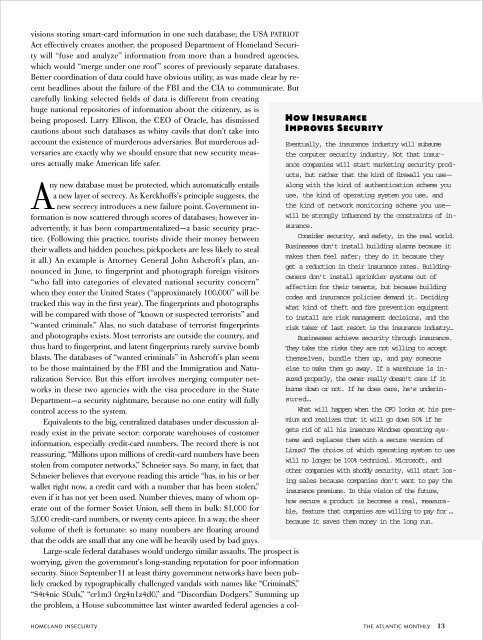HOMELAND INSECURITY - Charles C. Mann
HOMELAND INSECURITY - Charles C. Mann
HOMELAND INSECURITY - Charles C. Mann
You also want an ePaper? Increase the reach of your titles
YUMPU automatically turns print PDFs into web optimized ePapers that Google loves.
Sept-Insecurity.pages 6/28/02 10:37 AM Page 13<br />
visions storing smart-card information in one such database; the USA PATRIOT<br />
Act effectively creates another; the proposed Department of Homeland Security<br />
will “fuse and analyze” information from more than a hundred agencies,<br />
which would “merge under one roof” scores of previously separate databases.<br />
Better coordination of data could have obvious utility, as was made clear by recent<br />
headlines about the failure of the FBI and the CIA to communicate. But<br />
carefully linking selected fields of data is different from creating<br />
huge national repositories of information about the citizenry, as is<br />
being proposed. Larry Ellison, the CEO of Oracle, has dismissed<br />
cautions about such databases as whiny cavils that don’t take into<br />
account the existence of murderous adversaries. But murderous adversaries<br />
are exactly why we should ensure that new security measures<br />
actually make American life safer.<br />
Any new database must be protected, which automatically entails<br />
a new layer of secrecy. As Kerckhoffs’s principle suggests, the<br />
new secrecy introduces a new failure point. Government information<br />
is now scattered through scores of databases; however inadvertently,<br />
it has been compartmentalized—a basic security practice.<br />
(Following this practice, tourists divide their money between<br />
their wallets and hidden pouches; pickpockets are less likely to steal<br />
it all.) An example is Attorney General John Ashcroft’s plan, announced<br />
in June, to fingerprint and photograph foreign visitors<br />
“who fall into categories of elevated national security concern”<br />
when they enter the United States (“approximately 100,000” will be<br />
tracked this way in the first year). The fingerprints and photographs<br />
will be compared with those of “known or suspected terrorists” and<br />
“wanted criminals.” Alas, no such database of terrorist fingerprints<br />
and photographs exists. Most terrorists are outside the country, and<br />
thus hard to fingerprint, and latent fingerprints rarely survive bomb<br />
blasts. The databases of “wanted criminals” in Ashcroft’s plan seem<br />
to be those maintained by the FBI and the Immigration and Naturalization<br />
Service. But this effort involves merging computer networks<br />
in these two agencies with the visa procedure in the State<br />
Department—a security nightmare, because no one entity will fully<br />
control access to the system.<br />
Equivalents to the big, centralized databases under discussion already<br />
exist in the private sector: corporate warehouses of customer<br />
information, especially credit-card numbers. The record there is not<br />
reassuring. “Millions upon millions of credit-card numbers have been<br />
stolen from computer networks,” Schneier says. So many, in fact, that<br />
Schneier believes that everyone reading this article “has, in his or her<br />
wallet right now, a credit card with a number that has been stolen,”<br />
even if it has not yet been used. Number thieves, many of whom operate<br />
out of the former Soviet Union, sell them in bulk: $1,000 for<br />
5,000 credit-card numbers, or twenty cents apiece. In a way, the sheer<br />
volume of theft is fortunate: so many numbers are floating around<br />
that the odds are small that any one will be heavily used by bad guys.<br />
Large-scale federal databases would undergo similar assaults. The prospect is<br />
worrying, given the government’s long-standing reputation for poor information<br />
security. Since September 11 at least thirty government networks have been publicly<br />
cracked by typographically challenged vandals with names like “CriminalS,”<br />
“S4t4nic S0uls,” “cr1m3 0rg4n1z4d0,” and “Discordian Dodgers.” Summing up<br />
the problem, a House subcommittee last winter awarded federal agencies a col-<br />
HOW I NSURANCE<br />
I M PROVES SECURITY<br />
Eventually, the insurance industry will subsume<br />
the computer security industry. Not that insurance<br />
companies will start marketing security products,<br />
but rather that the kind of firewall you use—<br />
along with the kind of authentication scheme you<br />
use, the kind of operating system you use, and<br />
the kind of network monitoring scheme you use—<br />
will be strongly influenced by the constraints of insurance.<br />
Consider security, and safety, in the real world.<br />
Businesses don’t install building alarms because it<br />
makes them feel safer; they do it because they<br />
get a reduction in their insurance rates. Buildingowners<br />
don’t install sprinkler systems out of<br />
affection for their tenants, but because building<br />
codes and insurance policies demand it. Deciding<br />
what kind of theft and fire prevention equipment<br />
to install are risk management decisions, and the<br />
risk taker of last resort is the insurance industry…<br />
Businesses achieve security through insurance.<br />
They take the risks they are not willing to accept<br />
themselves, bundle them up, and pay someone<br />
else to make them go away. If a warehouse is insured<br />
properly, the owner really doesn’t care if it<br />
burns down or not. If he does care, he’s underinsured…<br />
What will happen when the CFO looks at his premium<br />
and realizes that it will go down 50% if he<br />
gets rid of all his insecure Windows operating systems<br />
and replaces them with a secure version of<br />
Linux? The choice of which operating system to use<br />
will no longer be 100% technical. Microsoft, and<br />
other companies with shoddy security, will start losing<br />
sales because companies don’t want to pay the<br />
insurance premiums. In this vision of the future,<br />
how secure a product is becomes a real, measurable,<br />
feature that companies are willing to pay for …<br />
because it saves them money in the long run.<br />
<strong>HOMELAND</strong> <strong>INSECURITY</strong> THE ATLANTIC MONTHLY 13




